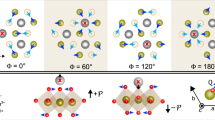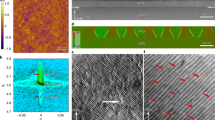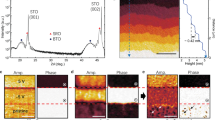Abstract
Ferroics, especially ferromagnets, can form complex topological spin structures such as vortices1 and skyrmions2,3 when subjected to particular electrical and mechanical boundary conditions. Simple vortex-like, electric-dipole-based topological structures have been observed in dedicated ferroelectric systems, especially ferroelectric–insulator superlattices such as PbTiO3/SrTiO3, which was later shown to be a model system owing to its high depolarizing field4,5,6,7,8. To date, the electric dipole equivalent of ordered magnetic spin lattices driven by the Dzyaloshinskii–Moriya interaction (DMi)9,10 has not been experimentally observed. Here we examine a domain structure in a single PbTiO3 epitaxial layer sandwiched between SrRuO3 electrodes. We observe periodic clockwise and anticlockwise ferroelectric vortices that are modulated by a second ordering along their toroidal core. The resulting topology, supported by calculations, is a labyrinth-like pattern with two orthogonal periodic modulations that form an incommensurate polar crystal that provides a ferroelectric analogue to the recently discovered incommensurate spin crystals in ferromagnetic materials11,12,13. These findings further blur the border between emergent ferromagnetic and ferroelectric topologies, clearing the way for experimental realization of further electric counterparts of magnetic DMi-driven phases.
This is a preview of subscription content, access via your institution
Access options
Access Nature and 54 other Nature Portfolio journals
Get Nature+, our best-value online-access subscription
$29.99 / 30 days
cancel any time
Subscribe to this journal
Receive 51 print issues and online access
$199.00 per year
only $3.90 per issue
Buy this article
- Purchase on Springer Link
- Instant access to full article PDF
Prices may be subject to local taxes which are calculated during checkout




Similar content being viewed by others
Data availability
The data that support the findings of this study are available at the University of Warwick open access research repository (http://wrap.warwick.ac.uk/159776/) or from the corresponding author on reasonable request.
References
Wachowiak, A. et al. Direct observation of internal spin structure of magnetic vortex cores. Science 298, 577–580 (2002).
Seki, S., Yu, X. Z., Ishiwata, S. & Tokura, Y. Observation of skyrmions in a multiferroic material. Science 336, 198–201 (2012).
Yu, X. Z. et al. Real-space observation of a two-dimensional skyrmion crystal. Nature 465, 901–904 (2010).
Yadav, A. K. et al. Observation of polar vortices in oxide superlattices. Nature 530, 198–201 (2016).
Hsu, S.-L. et al. Emergence of the vortex state in confined ferroelectric heterostructures. Adv. Mater. 31, 1901014–1901022 (2019).
Shafer, P. et al. Emergent chirality in the electric polarization texture of titanate superlattices. Proc. Natl Acad. Sci. USA 115, 915–920 (2018).
Gruverman, A. et al. Vortex ferroelectric domains. J. Phys. Condens. Matter 20, 4 (2008).
Nelson, C. T. et al. Spontaneous vortex nanodomain arrays at ferroelectric heterointerfaces. Nano Lett. 11, 828–834 (2011).
Dzyaloshinsky, I. Thermodynamic theory of weak ferromagnetism of antiferromagnetics. J. Phys. Chem. Solids 4, 241–255 (1958).
Moriya, T. Anisotropic superexchange interaction and weak ferromagnetism. Phys. Rev. 120, 91–98 (1960).
Kurumaji, T. et al. Néel-type skyrmion lattice in the tetragonal polar magnet VOSe2O5. Phys. Rev. Lett. 119, 237201–237205 (2017).
Kurumaji, T. et al. Direct observation of cycloidal spin modulation and field-induced transition in Néel-type skyrmion-hosting VOSe2O5. J. Phys. Soc. Jpn 90, 024705 (2021).
Seddon, S. D. et al. Real-space observation of ferroelectrically induced magnetic spin crystal in SrRuO3. Nat. Commun. 12, 2007 (2021).
Hong, Z. et al. Stability of polar vortex lattice in ferroelectric superlattices. Nano Lett. 17, 2246–2252 (2017).
Damodaran, A. R. et al. Phase coexistence and electric-field control of toroidal order in oxide superlattices. Nat. Mater. 16, 1003–1009 (2017).
Stoica, V. A. et al. Optical creation of a supercrystal with three-dimensional nanoscale periodicity. Nat. Mater. 18, 377–383 (2019).
Li, X. et al. Atomic-scale observations of electrical and mechanical manipulation of topological polar flux closure. Proc. Natl Acad. Sci. USA 117, 18954–18961 (2020).
Ponomareva, I., Naumov, I. I. & Bellaiche, L. Low-dimensional ferroelectrics under different electrical and mechanical boundary conditions: atomistic simulations. Phys. Rev. B 72, 214118 (2005).
Sanchez-Santolino, G. et al. Resonant electron tunnelling assisted by charged domain walls in multiferroic tunnel junctions. Nat. Nanotechnol. 12, 655–662 (2017).
Penthorn, N. E., Hao, X., Wang, Z., Hua, Y. & Jiang, H. W. Experimental observation of single skyrmion signatures in a magnetic tunnel junction. Phys. Rev. Lett. 122, 257201 (2019).
Peters, J. J. P., Apachitei, G., Beanland, R., Alexe, M. & Sanchez, A. M. Polarization curling and flux closures in multiferroic tunnel junctions. Nat. Commun. 7, 13484 (2016).
Hadjimichael, M. et al. Metal–ferroelectric supercrystals with periodically curved metallic layers. Nat. Mater. 20, 495–502 (2021).
Li, S. et al. Periodic arrays of flux-closure domains in ferroelectric thin films with oxide electrodes. Appl. Phys. Lett. 111, 052901 (2017).
Kurumaji, T. et al. Skyrmion lattice with a giant topological Hall effect in a frustrated triangular-lattice magnet. Science 365, 914–918 (2019).
Yi, S. D., Onoda, S., Nagaosa, N. & Han, J. H. Skyrmions and anomalous Hall effect in a Dzyaloshinskii-Moriya spiral magnet. Phys. Rev. B 80, 054416–054421 (2009).
Zhao, H. J., Chen, P., Prosandeev, S., Artyukhin, S. & Bellaiche, L. Dzyaloshinskii–Moriya-like interaction in ferroelectrics and antiferroelectrics. Nat. Mater. 20, 341–345 (2021).
Aguado-Puente, P. & Junquera, J. Ferromagnetic-like closure domains in ferroelectric ultrathin films: first-principles simulations. Phys. Rev. Lett. 100, 177601–177604 (2008).
Dürr, H. A. et al. Chiral magnetic domain structures in ultrathin FePd films. Science 284, 2166–2168 (1999).
Ahn, C. H. et al. Ferroelectric field effect in ultrathin SrRuO3 films. Appl. Phys. Lett. 70, 206–208 (1997).
Jia, C.-L. et al. Atomic-scale study of electric dipoles near charged and uncharged domain walls in ferroelectric films. Nat. Mater. 7, 57–61 (2008).
Naumov, I., Bellaiche, L. & Fu, H. Unusual phase transitions in ferroelectric nanodisks and nanorods. Nature 432, 737–740 (2004).
Junquera, J. & Ghosez, P. Critical thickness for ferroelectricity in perovskite ultrathin films. Nature 422, 506–509 (2003).
Nahas, Y. et al. Topology and control of self-assembled domain patterns in low-dimensional ferroelectrics. Nat. Commun. 11, 5779 (2020).
Nahas, Y. et al. Inverse transition of labyrinthine domain patterns in ferroelectric thin films. Nature 577, 47–51 (2020).
Carter, C. B. & Williams, D. B. Transmission Electron Microscopy: Diffraction, Imaging, and Spectrometry (Springer, 2016).
Bode, M. et al. Chiral magnetic order at surfaces driven by inversion asymmetry. Nature 447, 190–193 (2007).
Udalov, O. G., Beloborodov, I. S. & Sapozhnikov, M. V. Magnetic skyrmions and bimerons in films with anisotropic interfacial Dzyaloshinskii-Moriya interaction. Phys. Rev. B 103, 174416 (2021).
Chen, J., Zhang, D. W. & Liu, J. M. Exotic skyrmion crystals in chiral magnets with compass anisotropy. Sci. Rep. 6, 29126 (2016).
Saw, T. B. et al. Topological defects in epithelia govern cell death and extrusion. Nature 544, 212–216 (2017).
Tsesses, S. et al. Optical skyrmion lattice in evanescent electromagnetic fields. Science 361, 993–996 (2018).
Giannozzi, P. et al. Advanced capabilities for materials modelling with Quantum ESPRESSO. J. Phys. Condens. Matter 29, 465901 (2017).
Giannozzi, P. et al. QUANTUM ESPRESSO: a modular and open-source software project for quantum simulations of materials. J. Phys. Condens. Matter 21, 395502 (2009).
Perdew, J. P., Burke, K. & Ernzerhof, M. Generalized gradient approximation made simple. Phys. Rev. Lett. 77, 3865–3868 (1996).
Monkhorst, H. J. & Pack, J. D. Special points for Brillouin-zone integrations. Phys. Rev. B 13, 5188 (1976).
Zhang, Y., Sun, J., Perdew, J. P. & Wu, X. Comparative first-principles studies of prototypical ferroelectric materials by LDA, GGA, and SCAN meta-GGA. Phys. Rev. B 96, 035143 (2017).
Kolpak, A. M., Sai, N. & Rappe, A. Short-circuit boundary conditions in ferroelectric PbTiO3 thin films. Phys. Rev. B 74, 054112–054117 (2006).
Leferovich, R. P. & Mitchell, R. H. A structural study of ternary lanthanide orthoscandate perovskites. J. Solid State Chem. 177, 2188–2197 (2004).
Longo, V. M. et al. On the photoluminescence behavior of samarium-doped strontium titanate nanostructures under UV light. A structural and electronic understanding. Phys. Chem. Chem. Phys. 12, 7566–7579 (2010).
Bansal, C., Kawanaka, H., Takahashi, R. & Nishihara, Y. Metal–insulator transition in Fe-substituted SrRuO3 bad metal system. J. Alloys Compd. 360, 47–53 (2003).
Kuroiwa, Y., Aoyagi, S. & Sawada, A. Evidence for Pb-O covalency in tetragonal PbTiO3. Phys. Rev. Lett. 87, 217601–217605 (2001).
Jones, L. et al. Smart Align—a new tool for robust non-rigid registration of scanning microscope data. Adv. Struct. Chem. Imaging 1, 8 (2015).
Li, Q. et al. Quantification of flexoelectricity in PbTiO3/SrTiO3 superlattice polar vortices using machine learning and phase-field modeling. Nat. Commun. 8, 1468 (2017).
Aso, R., Kan, D., Shimakawa, Y. & Kurata, H. Octahedral tilt propagation controlled by A-site cation size at perovskite oxide heterointerfaces. Cryst. Growth Des. 14, 2128–2132 (2014).
Peters, J. J. P. et al. Polarization screening mechanisms at La0.7Sr0.3MnO3–PbTiO3 interfaces. ACS Appl. Mater. Interfaces 12, 10657–10663 (2020).
Sanchez-Santolino, G. et al. Oxygen octahedral distortions in LaMO3/SrTiO3 superlattices. Microsc. Microanal. 20, 825–831 (2014).
Rondinelli, J. M. & Spaldin, N. A. Structure and properties of functional oxide thin films: insights from electronic-structure calculations. Adv. Mater. 23, 3363–3381 (2011).
Sepliarsky, M., Stachiotti, M. G. & Migoni, R. L. Surface reconstruction and ferroelectricity in PbTiO3 thin films. Phys. Rev. B 72, 014110–014116 (2005).
Zhang, S. et al. Polarization rotation in ultrathin ferroelectrics tailored by interfacial oxygen octahedral coupling. ACS Nano 12, 3681–3688 (2018).
Acknowledgements
This work was partly supported by the EPSRC (UK) through grant nos. EP/P031544/1 and EP/P025803/1. M.A. acknowledges the Theo Murphy Blue Skies Award of the Royal Society. This research used resources of the Advanced Photon Source, a US Department of Energy (DOE) Office of Science user facility, operated for the DOE Office of Science by Argonne National Laboratory under contract no. DE-AC02-06CH11357. We also acknowledge the technical support from M. Crosbie. We would like to acknowledge the University of Warwick Research Technology Platform for assistance in the research described in this paper.
Author information
Authors and Affiliations
Contributions
M.A. conceived the idea. D.R., M.A. and A.M.S. designed the experiments. D.R. prepared the samples, performed DFT and DF-TEM experiments and analysed the data. J.J.P.P. and J.A.G. performed the STEM experiments and analysis. G.A.A.N., J.S., D.H. and D.R. collected the synchrotron data. T.P.A.H. and D.R. analysed the XRD data. R.B. performed the two-beam diffraction contrast simulations. All authors contributed to the discussions. All authors wrote the manuscript.
Corresponding author
Ethics declarations
Competing interests
The authors declare no competing interests.
Peer review information
Peer review information
Nature thanks the anonymous reviewers for their contribution to the peer review of this work.
Additional information
Publisher’s note Springer Nature remains neutral with regard to jurisdictional claims in published maps and institutional affiliations.
Extended data figures and tables
Extended Data Fig. 1 Structure characterization.
a, AFM topography of the surface of our (SrRuO3)11/(PbTiO3)13/(SrRuO3)11 trilayer sample. b, Low-magnification cross-sectional STEM of the sample. The scale bar is 10 nm.
Extended Data Fig. 2 RSM data.
a, 3D reciprocal space map around the DSO 002pc Bragg peak. The side panels show the 2D projected intensity of the recorded scatter. b, RSM around the asymmetric reflection (103)pc. c, Reciprocal space map Qz versus Qx. d, Comparison plot of the extracted Qz scan at Qx = 0 and Qx = 0.07 Å−1. e, Integrated (boxed area) line profile showing the first-order and second-order satellite peaks and their widths. f, Reciprocal space map Qz versus Qy. g, The integrated (boxed area) line profile shows weak first-order satellite peaks corresponding to a periodicity of about 8.05 nm. h, Plan-view projection into a Qx versus Qy RSM map with extracted line scans showing the in-plane distribution of the satellite peaks.
Extended Data Fig. 3 Cross-sectional DF-TEM.
a, Image of a (100)pc cross section taken under the g = 020pc excitation condition. b, Image of the same (100)pc cross section taken under the g = 002pc excitation. c, Image of a (010)pc cross section (that is, cut at 90° from a and b) taken using g = 002pc. The scale bars are 20 nm.
Extended Data Fig. 4 Plan-view DF-TEM.
a, Low-magnification plan view of the complex domain pattern take under the g1 = 110pc condition. The figure inset shows the enlarged boxed area. b, Plan-view dark-field image taken under g2 = 100pc. c, Plan-view diffraction contrast taken under g3 = 010pc excitation. The scale bars are 100 nm for a and 30 nm for b and c.
Extended Data Fig. 5 Noise filter.
a, 2D Fourier transform of the plan-view image taken under g1 = 110 excitation. b, Bandpass filter that removes the noise and retains the signal for |Q| < 0.16 nm−1. c, Bandpass filter that also removes the central spot and the signal for |Q| < 0.015 nm−1. The scale bar is 30 nm.
Extended Data Fig. 6 Filtered/unfiltered plan-view DF-TEM.
a, The bandpass filter improves the signal-to-noise ratio without introducing artefacts. Both the filtered and unfiltered images show, apart from the labyrinth pattern, a periodic modulation in the contrast along the individual domains. b, The second modulation permeates the labyrinth pattern.
Extended Data Fig. 7 Diffraction contrast simulations.
Left, experimental plan-view DF-TEM images of the vortex array. Note that the g = 110pc image is at higher magnification and Bragg filtered. Right, two-beam Howie–Whelan diffraction contrast simulations of the contrast arising from the strain fields of a 2D array of vortices as described in the main text (deviation parameter s = 0.01 nm). The scale bars are 30 nm for g = 010, 30 nm for g = 100 and 10 nm for g = 110.
Extended Data Fig. 8 Tilt map.
Left, oxygen tilt behaviour along a row of unit cells. Right, tilt map throughout the PTO layer.
Extended Data Fig. 9 Cross-sectional polar maps.
a, Polarization maps along the ordered [010]pc direction. The projection of a cycloidal and helical modulated vortex array into the [001]pc–[010]pc plane shows that the domain topology is retained. b, The projection of the modulated vortex array into the [001]pc–[100]pc plane shows that the cycloidal modulation allows the polar vector to rotate in plane, similar to the experimental polar map, whereas the helical modulation does not.
Extended Data Fig. 10 X-ray CD data.
a, [100]pc//[001]o in the scattering plane. b, [010]pc//[−110]o in the scattering plane. The first row presents the sum of the dichroic signal, (I+ + I−)/2, in which I± refers to the measured intensity for opposite helicities of the incoming light and the second row shows the CD signal, (I+ − I−)/(I+ + I−), and its behaviour on 180° rotation of the sample. The third panel shows the dichroic signal, (CDϕ1 − CDϕ2)/2, associated with a rotation of the sample by 180°, demonstrating a weak signal at the ± satellites in a, which is absent in b. In c and d, we show the dichroism under sample rotation when [100]pc//[001]o is in the scattering plane (c) and when the [010]pc//[−110]o direction is in the scattering plane (d). The upper panels of c and d plot the data from the two satellites onto a common axis, with the lower panels showing their average.
Supplementary information
Supplementary Information
This file contains Supplementary Text, Supplementary Figures 1–10 and Supplementary References.
Rights and permissions
About this article
Cite this article
Rusu, D., Peters, J.J.P., Hase, T.P.A. et al. Ferroelectric incommensurate spin crystals. Nature 602, 240–244 (2022). https://doi.org/10.1038/s41586-021-04260-1
Received:
Accepted:
Published:
Issue Date:
DOI: https://doi.org/10.1038/s41586-021-04260-1
This article is cited by
-
A 2D ferroelectric vortex pattern in twisted BaTiO3 freestanding layers
Nature (2024)
-
Layered ferroelectric materials make waves — and vortices
Nature (2024)
-
Giant electric field-induced second harmonic generation in polar skyrmions
Nature Communications (2024)
-
Electrically and mechanically driven rotation of polar spirals in a relaxor ferroelectric polymer
Nature Communications (2024)
-
Emergent chirality in a polar meron to skyrmion phase transition
Nature Communications (2023)
Comments
By submitting a comment you agree to abide by our Terms and Community Guidelines. If you find something abusive or that does not comply with our terms or guidelines please flag it as inappropriate.



